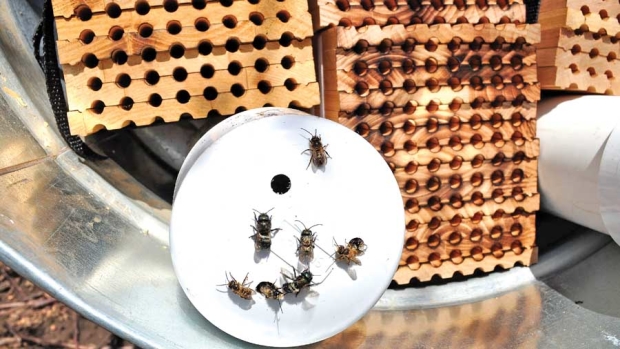
Dormant mason bees are delivered to the grower in a plastic tube with the hole taped closed. As soon as conditions warm up and the tape is removed, the bees will emerge. (Courtesy of Crown Bees.)
Bee biology researchers at Paramount Farming, a large California-based almond grower, are experimenting with commercial methods of propagating blue orchard mason bees to supplement pollination by honeybees.
The results of the research could be of significant aid to Pacific Northwest apple and cherry growers confronting decreasing supplies of honeybees as well.
Gordon Wardell, Paramount Farming’s lead bee biologist on this experiment, said the propagation project began five years ago, as Colony Collapse Disorder began seriously impacting honeybee hives.
The goal is to domesticate wild mason bees so as to assure a steady, predictable supply of these supplementary pollinators.
The domestication process is complex and begins with trapping mason bees in the wild.
Wardell negotiated with bee trappers in the Pacific Northwest, but found their prices too high. He now works with bee trappers in Utah and Idaho.
Since mason bees are solitary and live in individual nests, collecting wild specimens for use on the commercial propagation project is intricate and time-consuming.
Trappers put out artificial nests inhabited by “seed bees” as well as empty nests. Mason bee nesting grounds in forests are few and far between.
Thus, the seed bees act as beacons signaling the area is opportune for other bees to nest in. Trappers visit the area periodically and collect nests, always leaving enough bees behind to assure sustainable populations in the future.
“We don’t want to overstress the resource,” Wardell said.
The artificial nests are made of wooden blocks drilled with holes for the nesting bees.
The trappers also utilize paper tubes and reeds.
These artificial traps are clean and designed to be optimal structures for nesting, which helps attract bees. The nests that are removed contain developing bees in cocoons.
These are then transported to the Paramount Farming bee research facility near the small town of Lost Hills, about 60 miles west of Bakersfield.
The researchers optimize these bees’ natural development by bringing them inside and placing them in incubators.
They can also manipulate the temperature of the nests to result in earlier wintering times so that the bees will mature during the almond bloom season in February.
Eventually the hope is that, after the early wintering, future generations of domesticated mason bees can then be utilized in commercial numbers to pollinate almond and fruit orchards.
Currently, out of 100,000 bees in the cages, about only 50,000 will nest. The bees that survive and work best are selected as the next generation. Eventually Wardell and his team hope a generation of bees capable of sustaining commercially viable numbers will emerge.
Other obstacles encountered by the experimental program include natural predators such as wasps and beetles, which feed on the bees, as well as pesticide and fungicide spraying in proximity to nests and plants that the bees pollinate.
There are many variables still to work with as far as optimizing mason bee propagation, but Wardell said he’s confident he and his team will find the right combination that’ll enable them to “get through the genetic bottleneck” and provide growers with a commercially viable supply of domesticated mason bees. •
– by Brian Elsasser, a freelance writer based in Davis, California.






Leave A Comment